Unit 502: Theories, Principles, and Models of Teaching & Learning
VerifiedAdded on 2023/06/05
|15
|4863
|171
Report
AI Summary
This report, focusing on Unit 502, explores various theories, principles, and models essential for achieving inspirational teaching and learning, with a specific focus on the business specialism. It delves into principles of learning, including participation, repetition, relevance, transference, and feedback. The report examines prominent learning theories such as behaviorism, cognitivism, connectivism, and humanism, along with the Honey and Mumford model of learning styles. It also covers the application of learning models, analyzing learning preferences and their role in inclusive teaching. The report further analyzes models and theories of assessment (formative and summative), curriculum development, and reflection/evaluation, explaining their practical applications. The content is designed to provide a comprehensive understanding of how to effectively design and implement teaching strategies, assess student progress, and develop curricula that foster a positive learning environment. The report also emphasizes the importance of understanding student learning preferences and adapting teaching methods accordingly. This assignment is a valuable resource for educators seeking to improve their teaching practices and enhance student outcomes.
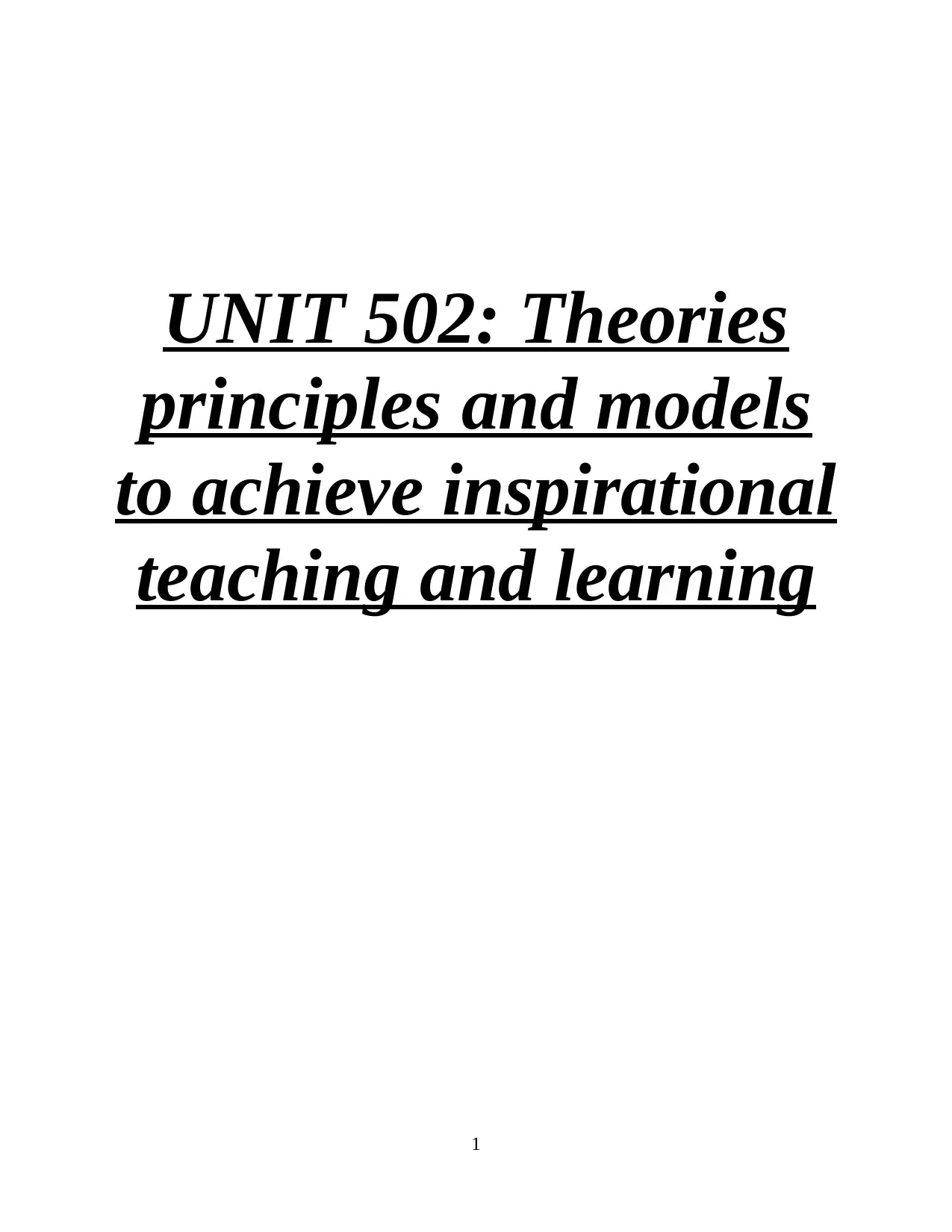
UNIT 502: Theories
principles and models
to achieve inspirational
teaching and learning
1
principles and models
to achieve inspirational
teaching and learning
1
Paraphrase This Document
Need a fresh take? Get an instant paraphrase of this document with our AI Paraphraser
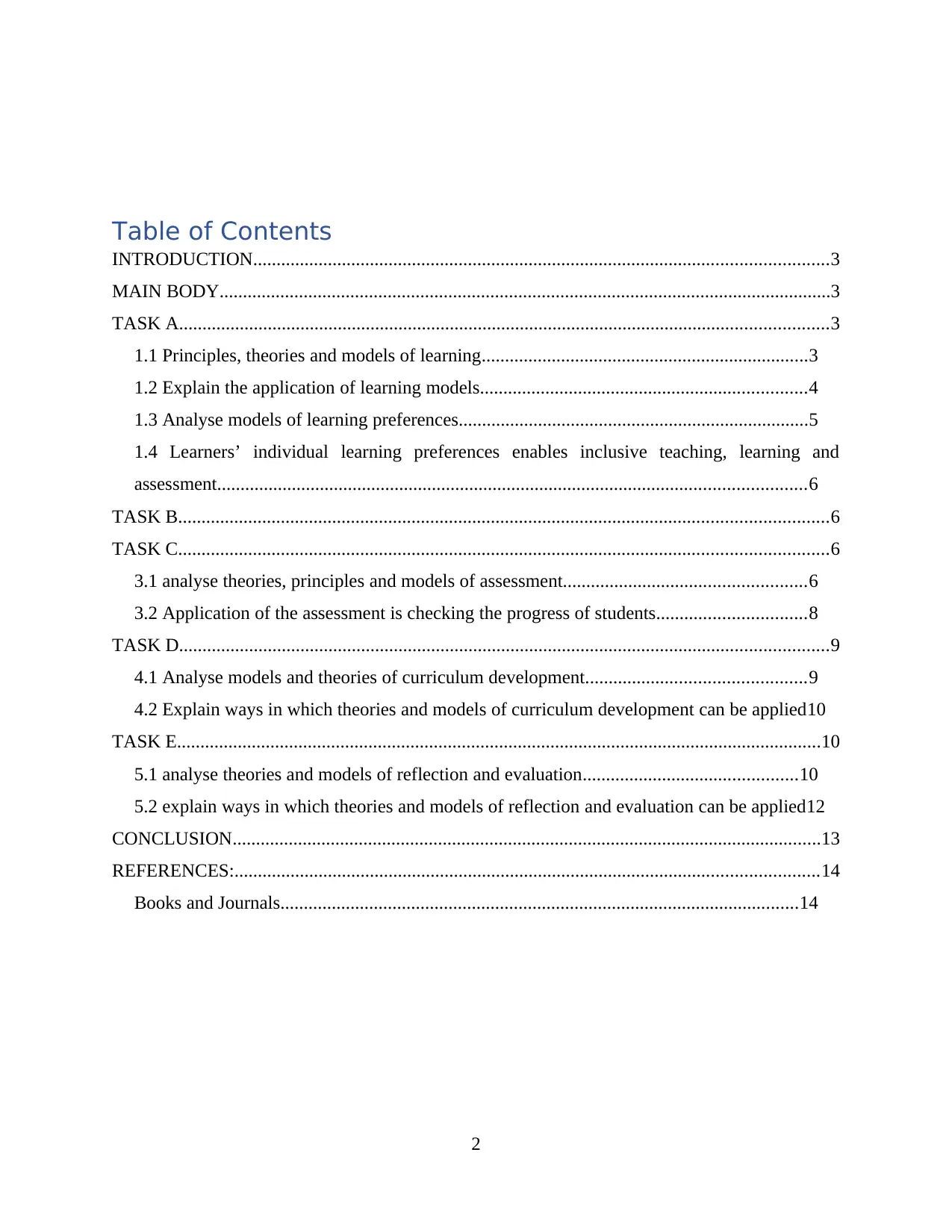
Table of Contents
INTRODUCTION...........................................................................................................................3
MAIN BODY...................................................................................................................................3
TASK A...........................................................................................................................................3
1.1 Principles, theories and models of learning......................................................................3
1.2 Explain the application of learning models......................................................................4
1.3 Analyse models of learning preferences...........................................................................5
1.4 Learners’ individual learning preferences enables inclusive teaching, learning and
assessment..............................................................................................................................6
TASK B...........................................................................................................................................6
TASK C...........................................................................................................................................6
3.1 analyse theories, principles and models of assessment....................................................6
3.2 Application of the assessment is checking the progress of students................................8
TASK D...........................................................................................................................................9
4.1 Analyse models and theories of curriculum development...............................................9
4.2 Explain ways in which theories and models of curriculum development can be applied10
TASK E..........................................................................................................................................10
5.1 analyse theories and models of reflection and evaluation..............................................10
5.2 explain ways in which theories and models of reflection and evaluation can be applied12
CONCLUSION..............................................................................................................................13
REFERENCES:.............................................................................................................................14
Books and Journals...............................................................................................................14
2
INTRODUCTION...........................................................................................................................3
MAIN BODY...................................................................................................................................3
TASK A...........................................................................................................................................3
1.1 Principles, theories and models of learning......................................................................3
1.2 Explain the application of learning models......................................................................4
1.3 Analyse models of learning preferences...........................................................................5
1.4 Learners’ individual learning preferences enables inclusive teaching, learning and
assessment..............................................................................................................................6
TASK B...........................................................................................................................................6
TASK C...........................................................................................................................................6
3.1 analyse theories, principles and models of assessment....................................................6
3.2 Application of the assessment is checking the progress of students................................8
TASK D...........................................................................................................................................9
4.1 Analyse models and theories of curriculum development...............................................9
4.2 Explain ways in which theories and models of curriculum development can be applied10
TASK E..........................................................................................................................................10
5.1 analyse theories and models of reflection and evaluation..............................................10
5.2 explain ways in which theories and models of reflection and evaluation can be applied12
CONCLUSION..............................................................................................................................13
REFERENCES:.............................................................................................................................14
Books and Journals...............................................................................................................14
2
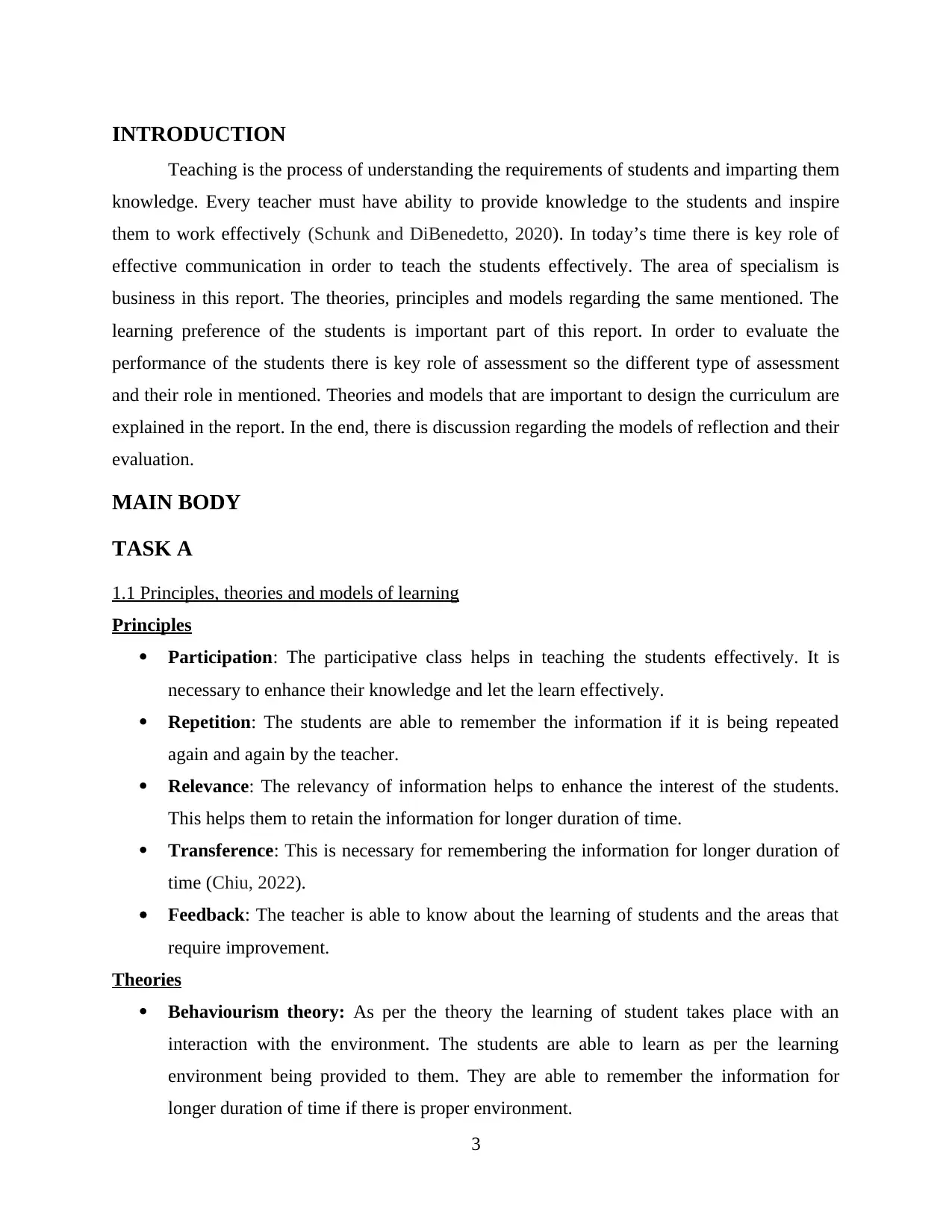
INTRODUCTION
Teaching is the process of understanding the requirements of students and imparting them
knowledge. Every teacher must have ability to provide knowledge to the students and inspire
them to work effectively (Schunk and DiBenedetto, 2020). In today’s time there is key role of
effective communication in order to teach the students effectively. The area of specialism is
business in this report. The theories, principles and models regarding the same mentioned. The
learning preference of the students is important part of this report. In order to evaluate the
performance of the students there is key role of assessment so the different type of assessment
and their role in mentioned. Theories and models that are important to design the curriculum are
explained in the report. In the end, there is discussion regarding the models of reflection and their
evaluation.
MAIN BODY
TASK A
1.1 Principles, theories and models of learning
Principles
Participation: The participative class helps in teaching the students effectively. It is
necessary to enhance their knowledge and let the learn effectively.
Repetition: The students are able to remember the information if it is being repeated
again and again by the teacher.
Relevance: The relevancy of information helps to enhance the interest of the students.
This helps them to retain the information for longer duration of time.
Transference: This is necessary for remembering the information for longer duration of
time (Chiu, 2022).
Feedback: The teacher is able to know about the learning of students and the areas that
require improvement.
Theories
Behaviourism theory: As per the theory the learning of student takes place with an
interaction with the environment. The students are able to learn as per the learning
environment being provided to them. They are able to remember the information for
longer duration of time if there is proper environment.
3
Teaching is the process of understanding the requirements of students and imparting them
knowledge. Every teacher must have ability to provide knowledge to the students and inspire
them to work effectively (Schunk and DiBenedetto, 2020). In today’s time there is key role of
effective communication in order to teach the students effectively. The area of specialism is
business in this report. The theories, principles and models regarding the same mentioned. The
learning preference of the students is important part of this report. In order to evaluate the
performance of the students there is key role of assessment so the different type of assessment
and their role in mentioned. Theories and models that are important to design the curriculum are
explained in the report. In the end, there is discussion regarding the models of reflection and their
evaluation.
MAIN BODY
TASK A
1.1 Principles, theories and models of learning
Principles
Participation: The participative class helps in teaching the students effectively. It is
necessary to enhance their knowledge and let the learn effectively.
Repetition: The students are able to remember the information if it is being repeated
again and again by the teacher.
Relevance: The relevancy of information helps to enhance the interest of the students.
This helps them to retain the information for longer duration of time.
Transference: This is necessary for remembering the information for longer duration of
time (Chiu, 2022).
Feedback: The teacher is able to know about the learning of students and the areas that
require improvement.
Theories
Behaviourism theory: As per the theory the learning of student takes place with an
interaction with the environment. The students are able to learn as per the learning
environment being provided to them. They are able to remember the information for
longer duration of time if there is proper environment.
3
⊘ This is a preview!⊘
Do you want full access?
Subscribe today to unlock all pages.

Trusted by 1+ million students worldwide
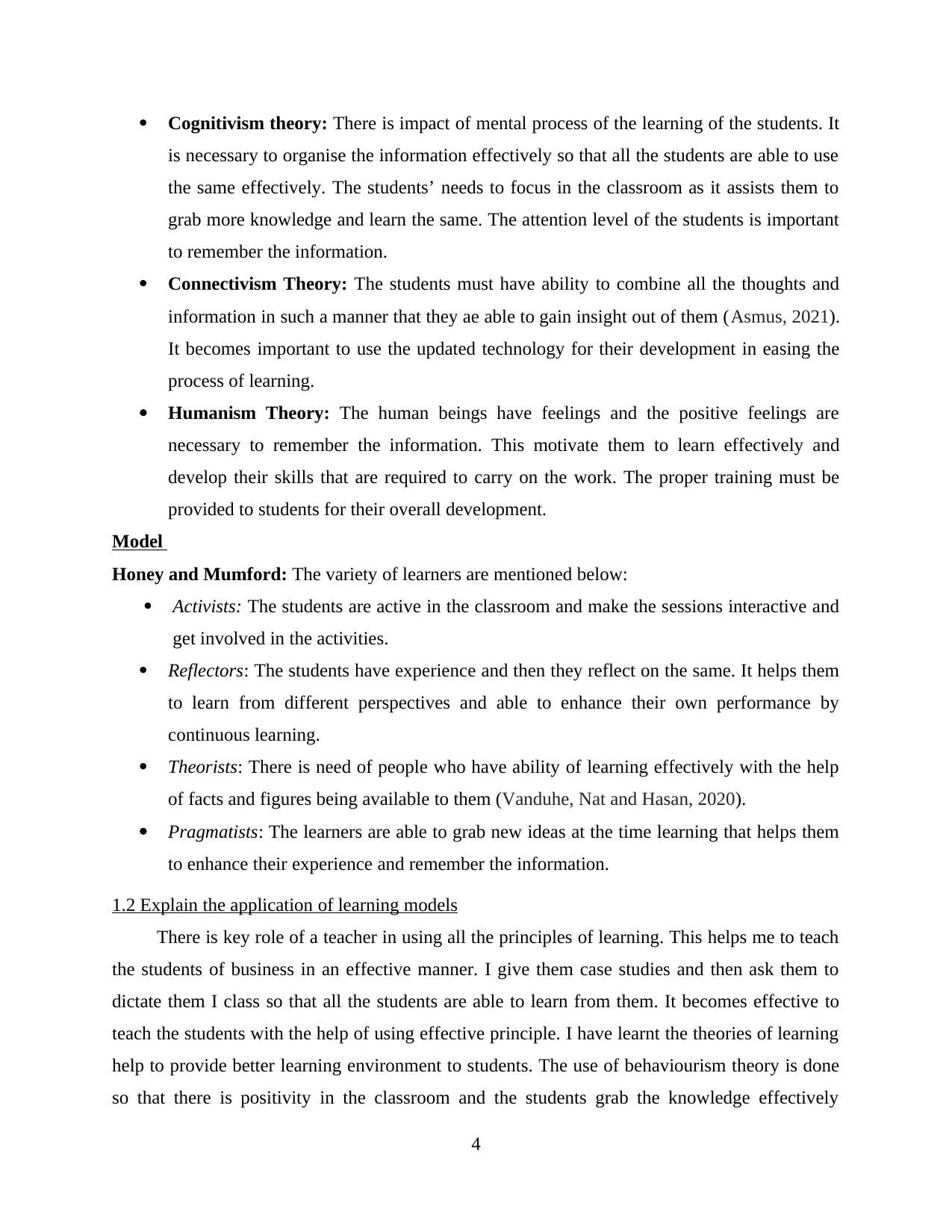
Cognitivism theory: There is impact of mental process of the learning of the students. It
is necessary to organise the information effectively so that all the students are able to use
the same effectively. The students’ needs to focus in the classroom as it assists them to
grab more knowledge and learn the same. The attention level of the students is important
to remember the information.
Connectivism Theory: The students must have ability to combine all the thoughts and
information in such a manner that they ae able to gain insight out of them (Asmus, 2021).
It becomes important to use the updated technology for their development in easing the
process of learning.
Humanism Theory: The human beings have feelings and the positive feelings are
necessary to remember the information. This motivate them to learn effectively and
develop their skills that are required to carry on the work. The proper training must be
provided to students for their overall development.
Model
Honey and Mumford: The variety of learners are mentioned below:
Activists: The students are active in the classroom and make the sessions interactive and
get involved in the activities.
Reflectors: The students have experience and then they reflect on the same. It helps them
to learn from different perspectives and able to enhance their own performance by
continuous learning.
Theorists: There is need of people who have ability of learning effectively with the help
of facts and figures being available to them (Vanduhe, Nat and Hasan, 2020).
Pragmatists: The learners are able to grab new ideas at the time learning that helps them
to enhance their experience and remember the information.
1.2 Explain the application of learning models
There is key role of a teacher in using all the principles of learning. This helps me to teach
the students of business in an effective manner. I give them case studies and then ask them to
dictate them I class so that all the students are able to learn from them. It becomes effective to
teach the students with the help of using effective principle. I have learnt the theories of learning
help to provide better learning environment to students. The use of behaviourism theory is done
so that there is positivity in the classroom and the students grab the knowledge effectively
4
is necessary to organise the information effectively so that all the students are able to use
the same effectively. The students’ needs to focus in the classroom as it assists them to
grab more knowledge and learn the same. The attention level of the students is important
to remember the information.
Connectivism Theory: The students must have ability to combine all the thoughts and
information in such a manner that they ae able to gain insight out of them (Asmus, 2021).
It becomes important to use the updated technology for their development in easing the
process of learning.
Humanism Theory: The human beings have feelings and the positive feelings are
necessary to remember the information. This motivate them to learn effectively and
develop their skills that are required to carry on the work. The proper training must be
provided to students for their overall development.
Model
Honey and Mumford: The variety of learners are mentioned below:
Activists: The students are active in the classroom and make the sessions interactive and
get involved in the activities.
Reflectors: The students have experience and then they reflect on the same. It helps them
to learn from different perspectives and able to enhance their own performance by
continuous learning.
Theorists: There is need of people who have ability of learning effectively with the help
of facts and figures being available to them (Vanduhe, Nat and Hasan, 2020).
Pragmatists: The learners are able to grab new ideas at the time learning that helps them
to enhance their experience and remember the information.
1.2 Explain the application of learning models
There is key role of a teacher in using all the principles of learning. This helps me to teach
the students of business in an effective manner. I give them case studies and then ask them to
dictate them I class so that all the students are able to learn from them. It becomes effective to
teach the students with the help of using effective principle. I have learnt the theories of learning
help to provide better learning environment to students. The use of behaviourism theory is done
so that there is positivity in the classroom and the students grab the knowledge effectively
4
Paraphrase This Document
Need a fresh take? Get an instant paraphrase of this document with our AI Paraphraser
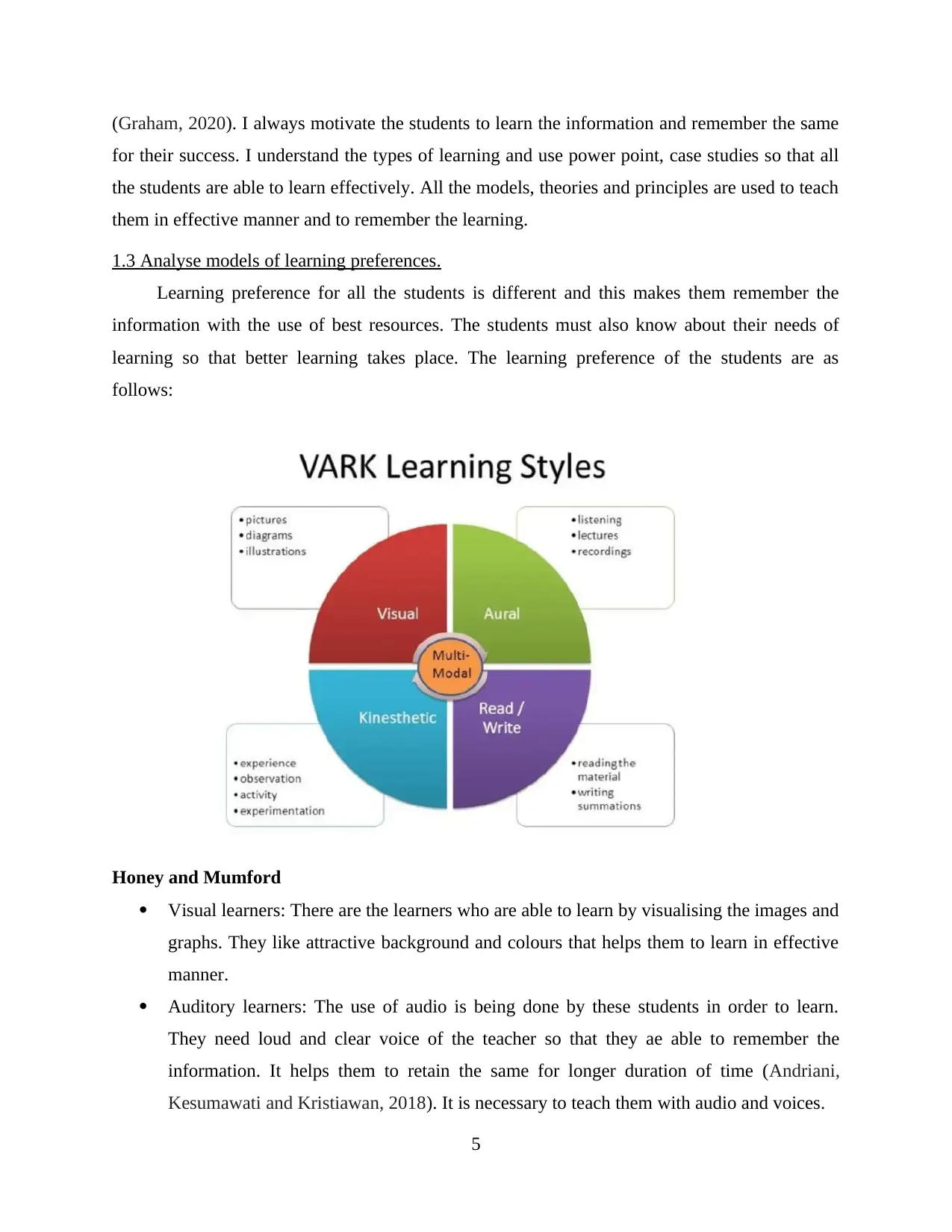
(Graham, 2020). I always motivate the students to learn the information and remember the same
for their success. I understand the types of learning and use power point, case studies so that all
the students are able to learn effectively. All the models, theories and principles are used to teach
them in effective manner and to remember the learning.
1.3 Analyse models of learning preferences.
Learning preference for all the students is different and this makes them remember the
information with the use of best resources. The students must also know about their needs of
learning so that better learning takes place. The learning preference of the students are as
follows:
Honey and Mumford
Visual learners: There are the learners who are able to learn by visualising the images and
graphs. They like attractive background and colours that helps them to learn in effective
manner.
Auditory learners: The use of audio is being done by these students in order to learn.
They need loud and clear voice of the teacher so that they ae able to remember the
information. It helps them to retain the same for longer duration of time (Andriani,
Kesumawati and Kristiawan, 2018). It is necessary to teach them with audio and voices.
5
for their success. I understand the types of learning and use power point, case studies so that all
the students are able to learn effectively. All the models, theories and principles are used to teach
them in effective manner and to remember the learning.
1.3 Analyse models of learning preferences.
Learning preference for all the students is different and this makes them remember the
information with the use of best resources. The students must also know about their needs of
learning so that better learning takes place. The learning preference of the students are as
follows:
Honey and Mumford
Visual learners: There are the learners who are able to learn by visualising the images and
graphs. They like attractive background and colours that helps them to learn in effective
manner.
Auditory learners: The use of audio is being done by these students in order to learn.
They need loud and clear voice of the teacher so that they ae able to remember the
information. It helps them to retain the same for longer duration of time (Andriani,
Kesumawati and Kristiawan, 2018). It is necessary to teach them with audio and voices.
5
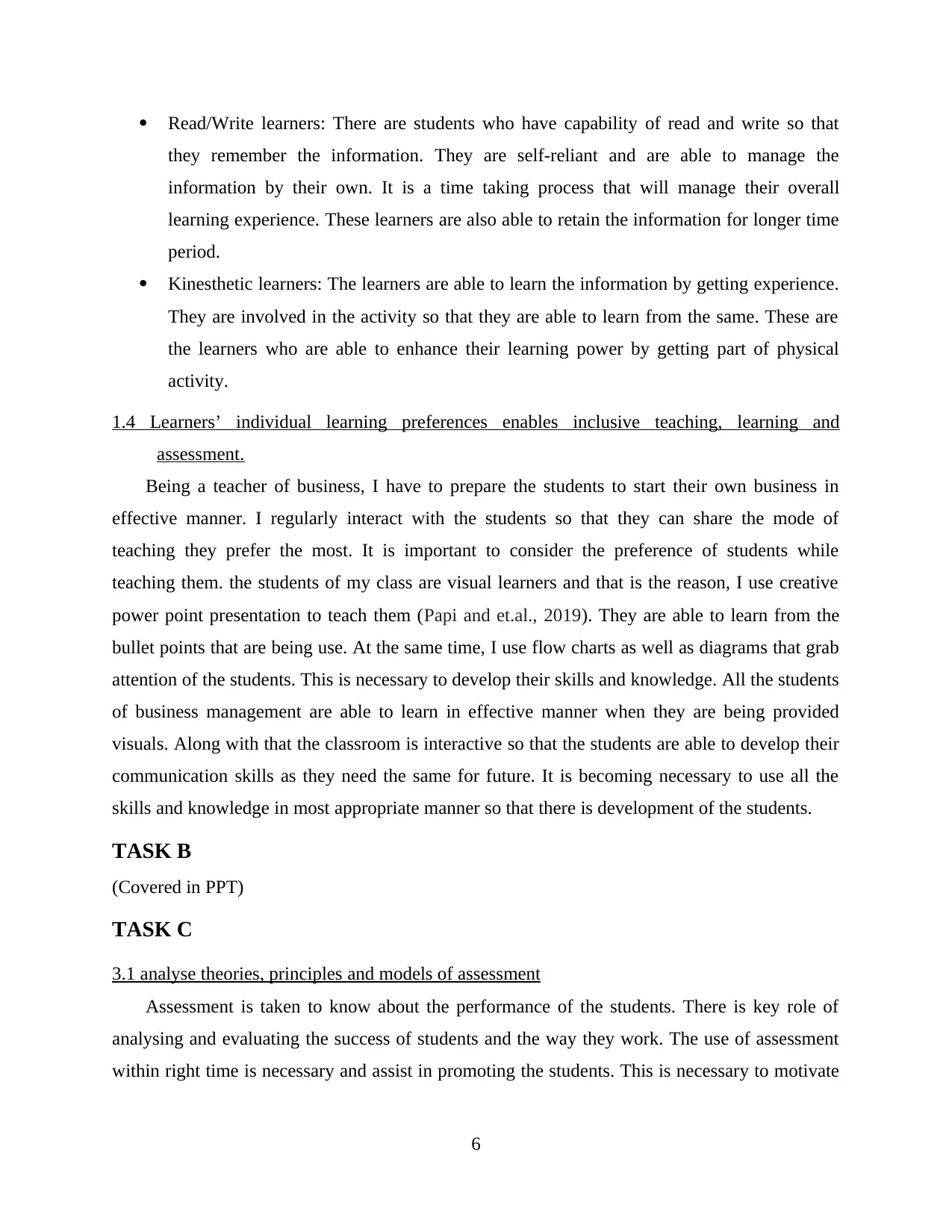
Read/Write learners: There are students who have capability of read and write so that
they remember the information. They are self-reliant and are able to manage the
information by their own. It is a time taking process that will manage their overall
learning experience. These learners are also able to retain the information for longer time
period.
Kinesthetic learners: The learners are able to learn the information by getting experience.
They are involved in the activity so that they are able to learn from the same. These are
the learners who are able to enhance their learning power by getting part of physical
activity.
1.4 Learners’ individual learning preferences enables inclusive teaching, learning and
assessment.
Being a teacher of business, I have to prepare the students to start their own business in
effective manner. I regularly interact with the students so that they can share the mode of
teaching they prefer the most. It is important to consider the preference of students while
teaching them. the students of my class are visual learners and that is the reason, I use creative
power point presentation to teach them (Papi and et.al., 2019). They are able to learn from the
bullet points that are being use. At the same time, I use flow charts as well as diagrams that grab
attention of the students. This is necessary to develop their skills and knowledge. All the students
of business management are able to learn in effective manner when they are being provided
visuals. Along with that the classroom is interactive so that the students are able to develop their
communication skills as they need the same for future. It is becoming necessary to use all the
skills and knowledge in most appropriate manner so that there is development of the students.
TASK B
(Covered in PPT)
TASK C
3.1 analyse theories, principles and models of assessment
Assessment is taken to know about the performance of the students. There is key role of
analysing and evaluating the success of students and the way they work. The use of assessment
within right time is necessary and assist in promoting the students. This is necessary to motivate
6
they remember the information. They are self-reliant and are able to manage the
information by their own. It is a time taking process that will manage their overall
learning experience. These learners are also able to retain the information for longer time
period.
Kinesthetic learners: The learners are able to learn the information by getting experience.
They are involved in the activity so that they are able to learn from the same. These are
the learners who are able to enhance their learning power by getting part of physical
activity.
1.4 Learners’ individual learning preferences enables inclusive teaching, learning and
assessment.
Being a teacher of business, I have to prepare the students to start their own business in
effective manner. I regularly interact with the students so that they can share the mode of
teaching they prefer the most. It is important to consider the preference of students while
teaching them. the students of my class are visual learners and that is the reason, I use creative
power point presentation to teach them (Papi and et.al., 2019). They are able to learn from the
bullet points that are being use. At the same time, I use flow charts as well as diagrams that grab
attention of the students. This is necessary to develop their skills and knowledge. All the students
of business management are able to learn in effective manner when they are being provided
visuals. Along with that the classroom is interactive so that the students are able to develop their
communication skills as they need the same for future. It is becoming necessary to use all the
skills and knowledge in most appropriate manner so that there is development of the students.
TASK B
(Covered in PPT)
TASK C
3.1 analyse theories, principles and models of assessment
Assessment is taken to know about the performance of the students. There is key role of
analysing and evaluating the success of students and the way they work. The use of assessment
within right time is necessary and assist in promoting the students. This is necessary to motivate
6
⊘ This is a preview!⊘
Do you want full access?
Subscribe today to unlock all pages.

Trusted by 1+ million students worldwide
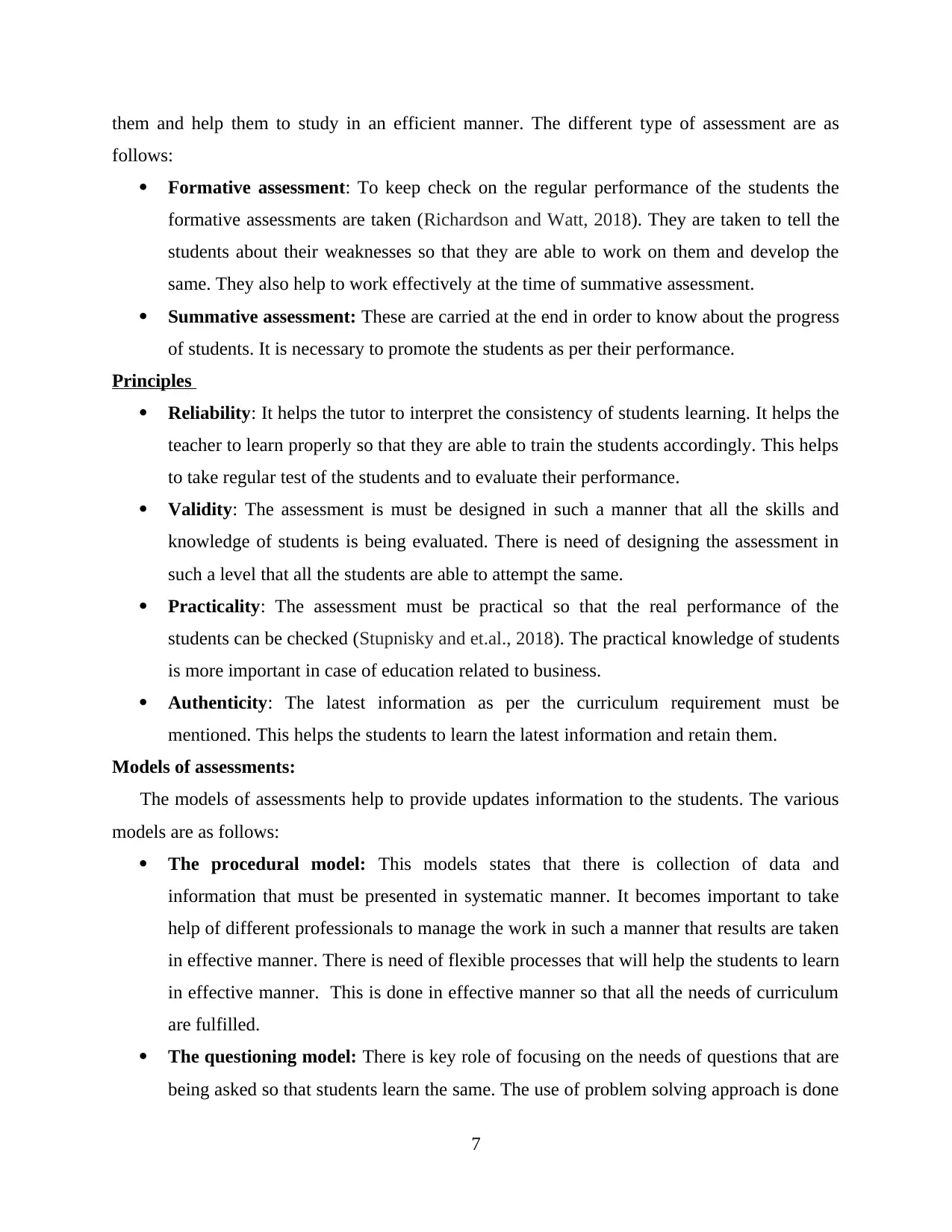
them and help them to study in an efficient manner. The different type of assessment are as
follows:
Formative assessment: To keep check on the regular performance of the students the
formative assessments are taken (Richardson and Watt, 2018). They are taken to tell the
students about their weaknesses so that they are able to work on them and develop the
same. They also help to work effectively at the time of summative assessment.
Summative assessment: These are carried at the end in order to know about the progress
of students. It is necessary to promote the students as per their performance.
Principles
Reliability: It helps the tutor to interpret the consistency of students learning. It helps the
teacher to learn properly so that they are able to train the students accordingly. This helps
to take regular test of the students and to evaluate their performance.
Validity: The assessment is must be designed in such a manner that all the skills and
knowledge of students is being evaluated. There is need of designing the assessment in
such a level that all the students are able to attempt the same.
Practicality: The assessment must be practical so that the real performance of the
students can be checked (Stupnisky and et.al., 2018). The practical knowledge of students
is more important in case of education related to business.
Authenticity: The latest information as per the curriculum requirement must be
mentioned. This helps the students to learn the latest information and retain them.
Models of assessments:
The models of assessments help to provide updates information to the students. The various
models are as follows:
The procedural model: This models states that there is collection of data and
information that must be presented in systematic manner. It becomes important to take
help of different professionals to manage the work in such a manner that results are taken
in effective manner. There is need of flexible processes that will help the students to learn
in effective manner. This is done in effective manner so that all the needs of curriculum
are fulfilled.
The questioning model: There is key role of focusing on the needs of questions that are
being asked so that students learn the same. The use of problem solving approach is done
7
follows:
Formative assessment: To keep check on the regular performance of the students the
formative assessments are taken (Richardson and Watt, 2018). They are taken to tell the
students about their weaknesses so that they are able to work on them and develop the
same. They also help to work effectively at the time of summative assessment.
Summative assessment: These are carried at the end in order to know about the progress
of students. It is necessary to promote the students as per their performance.
Principles
Reliability: It helps the tutor to interpret the consistency of students learning. It helps the
teacher to learn properly so that they are able to train the students accordingly. This helps
to take regular test of the students and to evaluate their performance.
Validity: The assessment is must be designed in such a manner that all the skills and
knowledge of students is being evaluated. There is need of designing the assessment in
such a level that all the students are able to attempt the same.
Practicality: The assessment must be practical so that the real performance of the
students can be checked (Stupnisky and et.al., 2018). The practical knowledge of students
is more important in case of education related to business.
Authenticity: The latest information as per the curriculum requirement must be
mentioned. This helps the students to learn the latest information and retain them.
Models of assessments:
The models of assessments help to provide updates information to the students. The various
models are as follows:
The procedural model: This models states that there is collection of data and
information that must be presented in systematic manner. It becomes important to take
help of different professionals to manage the work in such a manner that results are taken
in effective manner. There is need of flexible processes that will help the students to learn
in effective manner. This is done in effective manner so that all the needs of curriculum
are fulfilled.
The questioning model: There is key role of focusing on the needs of questions that are
being asked so that students learn the same. The use of problem solving approach is done
7
Paraphrase This Document
Need a fresh take? Get an instant paraphrase of this document with our AI Paraphraser
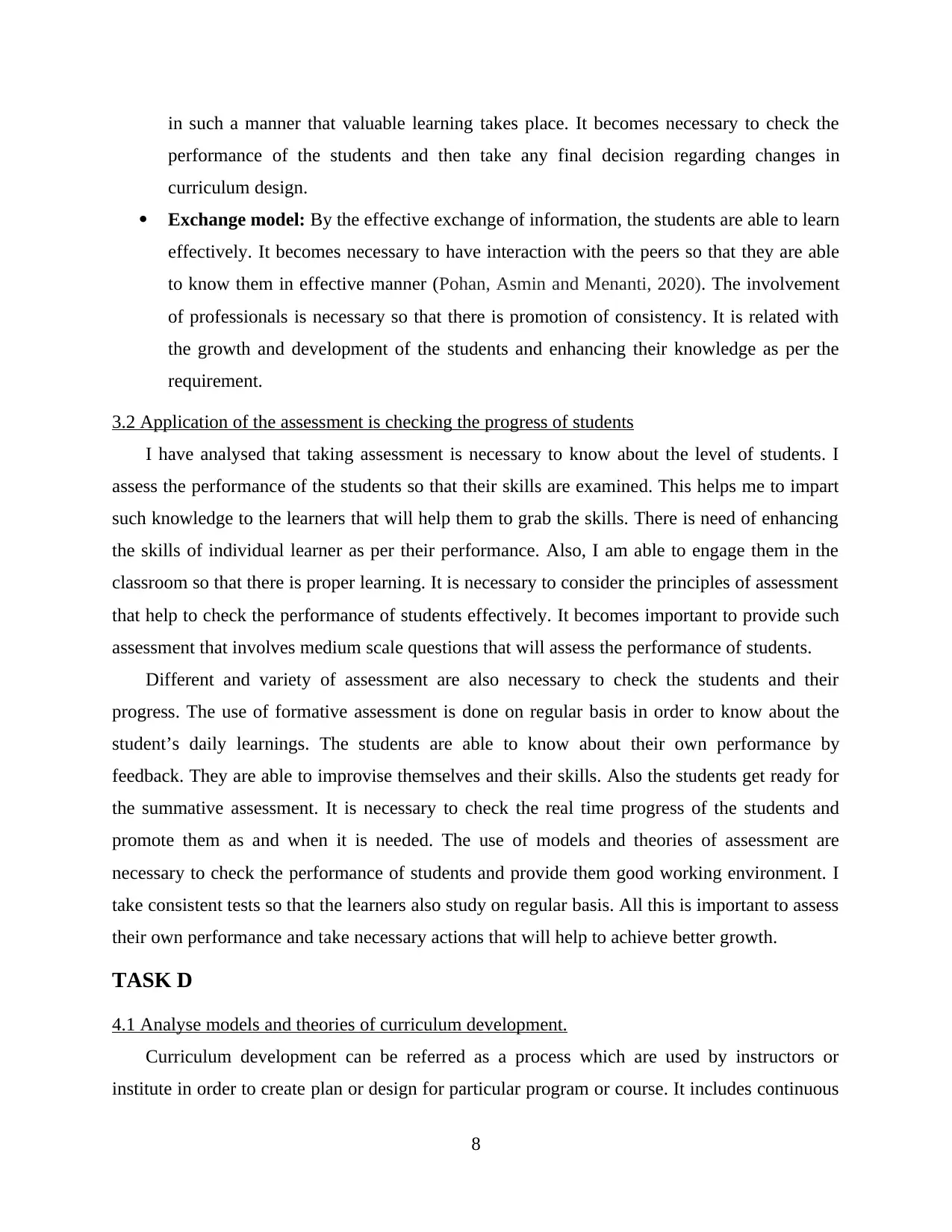
in such a manner that valuable learning takes place. It becomes necessary to check the
performance of the students and then take any final decision regarding changes in
curriculum design.
Exchange model: By the effective exchange of information, the students are able to learn
effectively. It becomes necessary to have interaction with the peers so that they are able
to know them in effective manner (Pohan, Asmin and Menanti, 2020). The involvement
of professionals is necessary so that there is promotion of consistency. It is related with
the growth and development of the students and enhancing their knowledge as per the
requirement.
3.2 Application of the assessment is checking the progress of students
I have analysed that taking assessment is necessary to know about the level of students. I
assess the performance of the students so that their skills are examined. This helps me to impart
such knowledge to the learners that will help them to grab the skills. There is need of enhancing
the skills of individual learner as per their performance. Also, I am able to engage them in the
classroom so that there is proper learning. It is necessary to consider the principles of assessment
that help to check the performance of students effectively. It becomes important to provide such
assessment that involves medium scale questions that will assess the performance of students.
Different and variety of assessment are also necessary to check the students and their
progress. The use of formative assessment is done on regular basis in order to know about the
student’s daily learnings. The students are able to know about their own performance by
feedback. They are able to improvise themselves and their skills. Also the students get ready for
the summative assessment. It is necessary to check the real time progress of the students and
promote them as and when it is needed. The use of models and theories of assessment are
necessary to check the performance of students and provide them good working environment. I
take consistent tests so that the learners also study on regular basis. All this is important to assess
their own performance and take necessary actions that will help to achieve better growth.
TASK D
4.1 Analyse models and theories of curriculum development.
Curriculum development can be referred as a process which are used by instructors or
institute in order to create plan or design for particular program or course. It includes continuous
8
performance of the students and then take any final decision regarding changes in
curriculum design.
Exchange model: By the effective exchange of information, the students are able to learn
effectively. It becomes necessary to have interaction with the peers so that they are able
to know them in effective manner (Pohan, Asmin and Menanti, 2020). The involvement
of professionals is necessary so that there is promotion of consistency. It is related with
the growth and development of the students and enhancing their knowledge as per the
requirement.
3.2 Application of the assessment is checking the progress of students
I have analysed that taking assessment is necessary to know about the level of students. I
assess the performance of the students so that their skills are examined. This helps me to impart
such knowledge to the learners that will help them to grab the skills. There is need of enhancing
the skills of individual learner as per their performance. Also, I am able to engage them in the
classroom so that there is proper learning. It is necessary to consider the principles of assessment
that help to check the performance of students effectively. It becomes important to provide such
assessment that involves medium scale questions that will assess the performance of students.
Different and variety of assessment are also necessary to check the students and their
progress. The use of formative assessment is done on regular basis in order to know about the
student’s daily learnings. The students are able to know about their own performance by
feedback. They are able to improvise themselves and their skills. Also the students get ready for
the summative assessment. It is necessary to check the real time progress of the students and
promote them as and when it is needed. The use of models and theories of assessment are
necessary to check the performance of students and provide them good working environment. I
take consistent tests so that the learners also study on regular basis. All this is important to assess
their own performance and take necessary actions that will help to achieve better growth.
TASK D
4.1 Analyse models and theories of curriculum development.
Curriculum development can be referred as a process which are used by instructors or
institute in order to create plan or design for particular program or course. It includes continuous
8
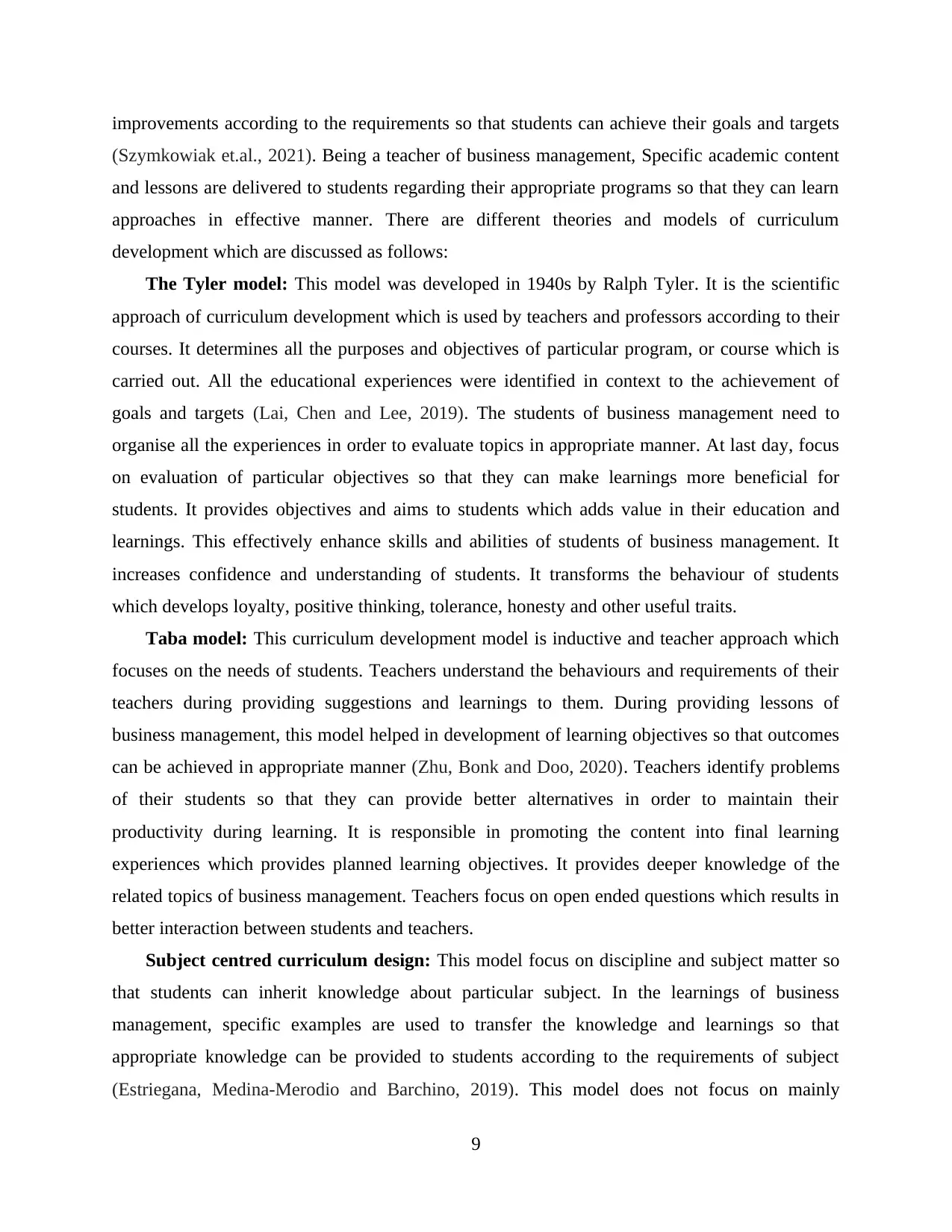
improvements according to the requirements so that students can achieve their goals and targets
(Szymkowiak et.al., 2021). Being a teacher of business management, Specific academic content
and lessons are delivered to students regarding their appropriate programs so that they can learn
approaches in effective manner. There are different theories and models of curriculum
development which are discussed as follows:
The Tyler model: This model was developed in 1940s by Ralph Tyler. It is the scientific
approach of curriculum development which is used by teachers and professors according to their
courses. It determines all the purposes and objectives of particular program, or course which is
carried out. All the educational experiences were identified in context to the achievement of
goals and targets (Lai, Chen and Lee, 2019). The students of business management need to
organise all the experiences in order to evaluate topics in appropriate manner. At last day, focus
on evaluation of particular objectives so that they can make learnings more beneficial for
students. It provides objectives and aims to students which adds value in their education and
learnings. This effectively enhance skills and abilities of students of business management. It
increases confidence and understanding of students. It transforms the behaviour of students
which develops loyalty, positive thinking, tolerance, honesty and other useful traits.
Taba model: This curriculum development model is inductive and teacher approach which
focuses on the needs of students. Teachers understand the behaviours and requirements of their
teachers during providing suggestions and learnings to them. During providing lessons of
business management, this model helped in development of learning objectives so that outcomes
can be achieved in appropriate manner (Zhu, Bonk and Doo, 2020). Teachers identify problems
of their students so that they can provide better alternatives in order to maintain their
productivity during learning. It is responsible in promoting the content into final learning
experiences which provides planned learning objectives. It provides deeper knowledge of the
related topics of business management. Teachers focus on open ended questions which results in
better interaction between students and teachers.
Subject centred curriculum design: This model focus on discipline and subject matter so
that students can inherit knowledge about particular subject. In the learnings of business
management, specific examples are used to transfer the knowledge and learnings so that
appropriate knowledge can be provided to students according to the requirements of subject
(Estriegana, Medina-Merodio and Barchino, 2019). This model does not focus on mainly
9
(Szymkowiak et.al., 2021). Being a teacher of business management, Specific academic content
and lessons are delivered to students regarding their appropriate programs so that they can learn
approaches in effective manner. There are different theories and models of curriculum
development which are discussed as follows:
The Tyler model: This model was developed in 1940s by Ralph Tyler. It is the scientific
approach of curriculum development which is used by teachers and professors according to their
courses. It determines all the purposes and objectives of particular program, or course which is
carried out. All the educational experiences were identified in context to the achievement of
goals and targets (Lai, Chen and Lee, 2019). The students of business management need to
organise all the experiences in order to evaluate topics in appropriate manner. At last day, focus
on evaluation of particular objectives so that they can make learnings more beneficial for
students. It provides objectives and aims to students which adds value in their education and
learnings. This effectively enhance skills and abilities of students of business management. It
increases confidence and understanding of students. It transforms the behaviour of students
which develops loyalty, positive thinking, tolerance, honesty and other useful traits.
Taba model: This curriculum development model is inductive and teacher approach which
focuses on the needs of students. Teachers understand the behaviours and requirements of their
teachers during providing suggestions and learnings to them. During providing lessons of
business management, this model helped in development of learning objectives so that outcomes
can be achieved in appropriate manner (Zhu, Bonk and Doo, 2020). Teachers identify problems
of their students so that they can provide better alternatives in order to maintain their
productivity during learning. It is responsible in promoting the content into final learning
experiences which provides planned learning objectives. It provides deeper knowledge of the
related topics of business management. Teachers focus on open ended questions which results in
better interaction between students and teachers.
Subject centred curriculum design: This model focus on discipline and subject matter so
that students can inherit knowledge about particular subject. In the learnings of business
management, specific examples are used to transfer the knowledge and learnings so that
appropriate knowledge can be provided to students according to the requirements of subject
(Estriegana, Medina-Merodio and Barchino, 2019). This model does not focus on mainly
9
⊘ This is a preview!⊘
Do you want full access?
Subscribe today to unlock all pages.

Trusted by 1+ million students worldwide
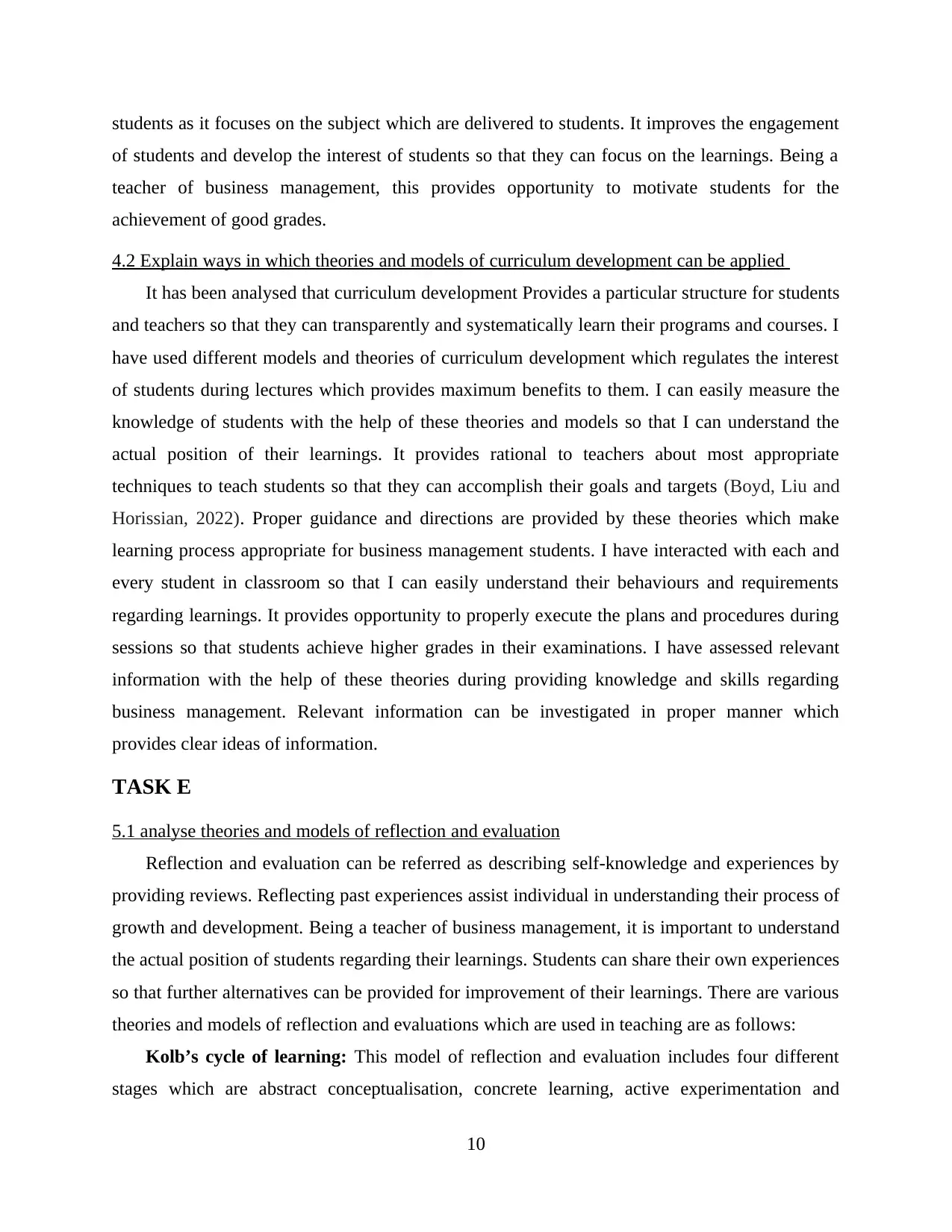
students as it focuses on the subject which are delivered to students. It improves the engagement
of students and develop the interest of students so that they can focus on the learnings. Being a
teacher of business management, this provides opportunity to motivate students for the
achievement of good grades.
4.2 Explain ways in which theories and models of curriculum development can be applied
It has been analysed that curriculum development Provides a particular structure for students
and teachers so that they can transparently and systematically learn their programs and courses. I
have used different models and theories of curriculum development which regulates the interest
of students during lectures which provides maximum benefits to them. I can easily measure the
knowledge of students with the help of these theories and models so that I can understand the
actual position of their learnings. It provides rational to teachers about most appropriate
techniques to teach students so that they can accomplish their goals and targets (Boyd, Liu and
Horissian, 2022). Proper guidance and directions are provided by these theories which make
learning process appropriate for business management students. I have interacted with each and
every student in classroom so that I can easily understand their behaviours and requirements
regarding learnings. It provides opportunity to properly execute the plans and procedures during
sessions so that students achieve higher grades in their examinations. I have assessed relevant
information with the help of these theories during providing knowledge and skills regarding
business management. Relevant information can be investigated in proper manner which
provides clear ideas of information.
TASK E
5.1 analyse theories and models of reflection and evaluation
Reflection and evaluation can be referred as describing self-knowledge and experiences by
providing reviews. Reflecting past experiences assist individual in understanding their process of
growth and development. Being a teacher of business management, it is important to understand
the actual position of students regarding their learnings. Students can share their own experiences
so that further alternatives can be provided for improvement of their learnings. There are various
theories and models of reflection and evaluations which are used in teaching are as follows:
Kolb’s cycle of learning: This model of reflection and evaluation includes four different
stages which are abstract conceptualisation, concrete learning, active experimentation and
10
of students and develop the interest of students so that they can focus on the learnings. Being a
teacher of business management, this provides opportunity to motivate students for the
achievement of good grades.
4.2 Explain ways in which theories and models of curriculum development can be applied
It has been analysed that curriculum development Provides a particular structure for students
and teachers so that they can transparently and systematically learn their programs and courses. I
have used different models and theories of curriculum development which regulates the interest
of students during lectures which provides maximum benefits to them. I can easily measure the
knowledge of students with the help of these theories and models so that I can understand the
actual position of their learnings. It provides rational to teachers about most appropriate
techniques to teach students so that they can accomplish their goals and targets (Boyd, Liu and
Horissian, 2022). Proper guidance and directions are provided by these theories which make
learning process appropriate for business management students. I have interacted with each and
every student in classroom so that I can easily understand their behaviours and requirements
regarding learnings. It provides opportunity to properly execute the plans and procedures during
sessions so that students achieve higher grades in their examinations. I have assessed relevant
information with the help of these theories during providing knowledge and skills regarding
business management. Relevant information can be investigated in proper manner which
provides clear ideas of information.
TASK E
5.1 analyse theories and models of reflection and evaluation
Reflection and evaluation can be referred as describing self-knowledge and experiences by
providing reviews. Reflecting past experiences assist individual in understanding their process of
growth and development. Being a teacher of business management, it is important to understand
the actual position of students regarding their learnings. Students can share their own experiences
so that further alternatives can be provided for improvement of their learnings. There are various
theories and models of reflection and evaluations which are used in teaching are as follows:
Kolb’s cycle of learning: This model of reflection and evaluation includes four different
stages which are abstract conceptualisation, concrete learning, active experimentation and
10
Paraphrase This Document
Need a fresh take? Get an instant paraphrase of this document with our AI Paraphraser
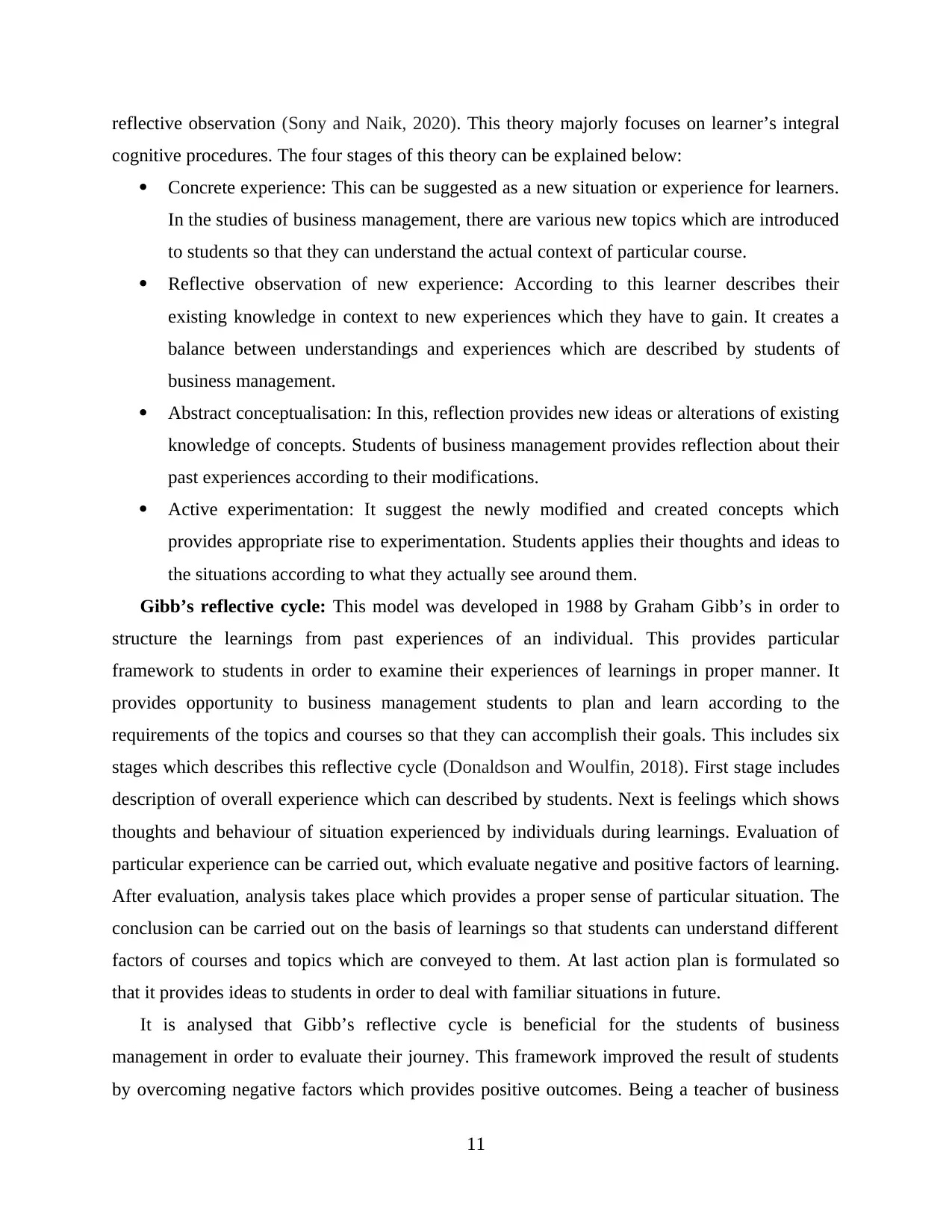
reflective observation (Sony and Naik, 2020). This theory majorly focuses on learner’s integral
cognitive procedures. The four stages of this theory can be explained below:
Concrete experience: This can be suggested as a new situation or experience for learners.
In the studies of business management, there are various new topics which are introduced
to students so that they can understand the actual context of particular course.
Reflective observation of new experience: According to this learner describes their
existing knowledge in context to new experiences which they have to gain. It creates a
balance between understandings and experiences which are described by students of
business management.
Abstract conceptualisation: In this, reflection provides new ideas or alterations of existing
knowledge of concepts. Students of business management provides reflection about their
past experiences according to their modifications.
Active experimentation: It suggest the newly modified and created concepts which
provides appropriate rise to experimentation. Students applies their thoughts and ideas to
the situations according to what they actually see around them.
Gibb’s reflective cycle: This model was developed in 1988 by Graham Gibb’s in order to
structure the learnings from past experiences of an individual. This provides particular
framework to students in order to examine their experiences of learnings in proper manner. It
provides opportunity to business management students to plan and learn according to the
requirements of the topics and courses so that they can accomplish their goals. This includes six
stages which describes this reflective cycle (Donaldson and Woulfin, 2018). First stage includes
description of overall experience which can described by students. Next is feelings which shows
thoughts and behaviour of situation experienced by individuals during learnings. Evaluation of
particular experience can be carried out, which evaluate negative and positive factors of learning.
After evaluation, analysis takes place which provides a proper sense of particular situation. The
conclusion can be carried out on the basis of learnings so that students can understand different
factors of courses and topics which are conveyed to them. At last action plan is formulated so
that it provides ideas to students in order to deal with familiar situations in future.
It is analysed that Gibb’s reflective cycle is beneficial for the students of business
management in order to evaluate their journey. This framework improved the result of students
by overcoming negative factors which provides positive outcomes. Being a teacher of business
11
cognitive procedures. The four stages of this theory can be explained below:
Concrete experience: This can be suggested as a new situation or experience for learners.
In the studies of business management, there are various new topics which are introduced
to students so that they can understand the actual context of particular course.
Reflective observation of new experience: According to this learner describes their
existing knowledge in context to new experiences which they have to gain. It creates a
balance between understandings and experiences which are described by students of
business management.
Abstract conceptualisation: In this, reflection provides new ideas or alterations of existing
knowledge of concepts. Students of business management provides reflection about their
past experiences according to their modifications.
Active experimentation: It suggest the newly modified and created concepts which
provides appropriate rise to experimentation. Students applies their thoughts and ideas to
the situations according to what they actually see around them.
Gibb’s reflective cycle: This model was developed in 1988 by Graham Gibb’s in order to
structure the learnings from past experiences of an individual. This provides particular
framework to students in order to examine their experiences of learnings in proper manner. It
provides opportunity to business management students to plan and learn according to the
requirements of the topics and courses so that they can accomplish their goals. This includes six
stages which describes this reflective cycle (Donaldson and Woulfin, 2018). First stage includes
description of overall experience which can described by students. Next is feelings which shows
thoughts and behaviour of situation experienced by individuals during learnings. Evaluation of
particular experience can be carried out, which evaluate negative and positive factors of learning.
After evaluation, analysis takes place which provides a proper sense of particular situation. The
conclusion can be carried out on the basis of learnings so that students can understand different
factors of courses and topics which are conveyed to them. At last action plan is formulated so
that it provides ideas to students in order to deal with familiar situations in future.
It is analysed that Gibb’s reflective cycle is beneficial for the students of business
management in order to evaluate their journey. This framework improved the result of students
by overcoming negative factors which provides positive outcomes. Being a teacher of business
11
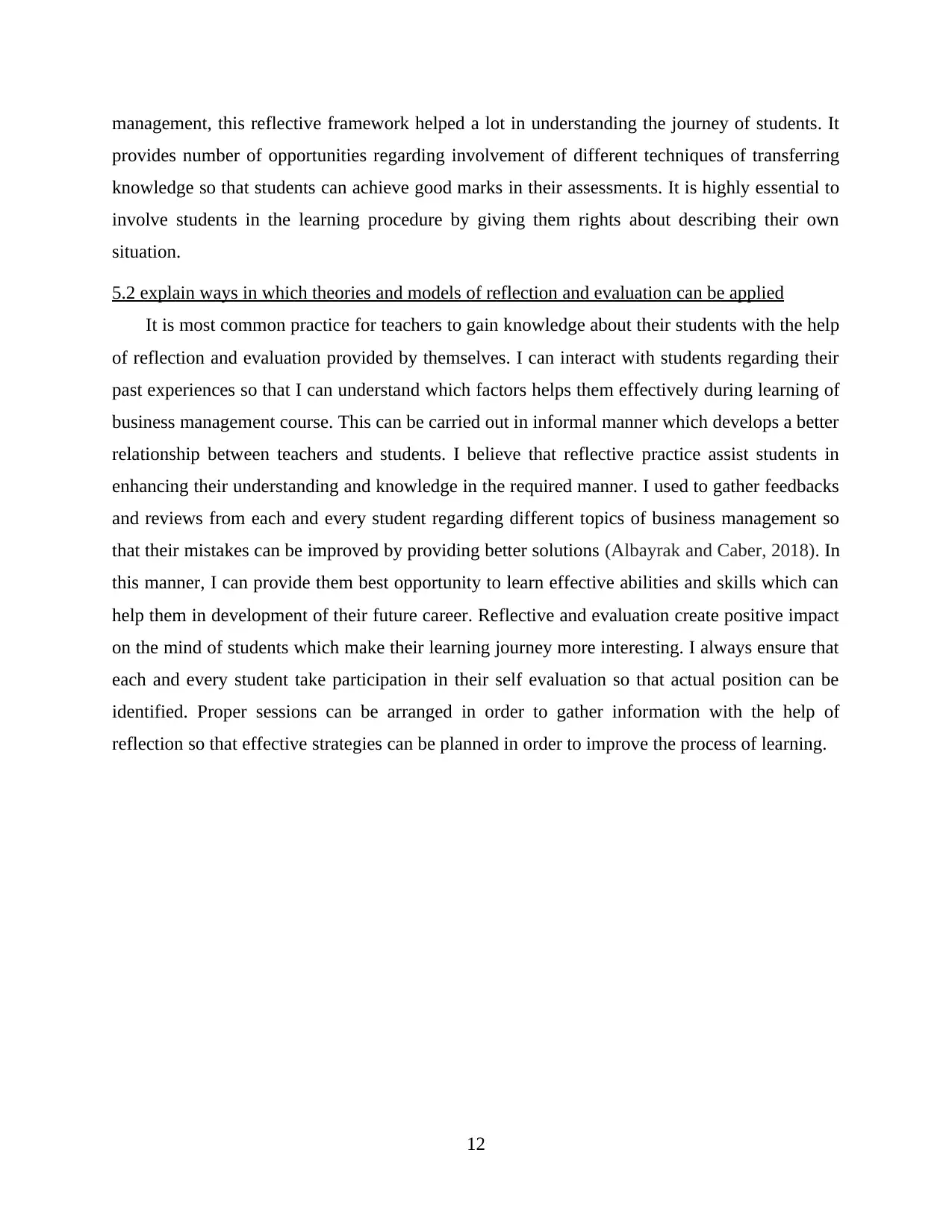
management, this reflective framework helped a lot in understanding the journey of students. It
provides number of opportunities regarding involvement of different techniques of transferring
knowledge so that students can achieve good marks in their assessments. It is highly essential to
involve students in the learning procedure by giving them rights about describing their own
situation.
5.2 explain ways in which theories and models of reflection and evaluation can be applied
It is most common practice for teachers to gain knowledge about their students with the help
of reflection and evaluation provided by themselves. I can interact with students regarding their
past experiences so that I can understand which factors helps them effectively during learning of
business management course. This can be carried out in informal manner which develops a better
relationship between teachers and students. I believe that reflective practice assist students in
enhancing their understanding and knowledge in the required manner. I used to gather feedbacks
and reviews from each and every student regarding different topics of business management so
that their mistakes can be improved by providing better solutions (Albayrak and Caber, 2018). In
this manner, I can provide them best opportunity to learn effective abilities and skills which can
help them in development of their future career. Reflective and evaluation create positive impact
on the mind of students which make their learning journey more interesting. I always ensure that
each and every student take participation in their self evaluation so that actual position can be
identified. Proper sessions can be arranged in order to gather information with the help of
reflection so that effective strategies can be planned in order to improve the process of learning.
12
provides number of opportunities regarding involvement of different techniques of transferring
knowledge so that students can achieve good marks in their assessments. It is highly essential to
involve students in the learning procedure by giving them rights about describing their own
situation.
5.2 explain ways in which theories and models of reflection and evaluation can be applied
It is most common practice for teachers to gain knowledge about their students with the help
of reflection and evaluation provided by themselves. I can interact with students regarding their
past experiences so that I can understand which factors helps them effectively during learning of
business management course. This can be carried out in informal manner which develops a better
relationship between teachers and students. I believe that reflective practice assist students in
enhancing their understanding and knowledge in the required manner. I used to gather feedbacks
and reviews from each and every student regarding different topics of business management so
that their mistakes can be improved by providing better solutions (Albayrak and Caber, 2018). In
this manner, I can provide them best opportunity to learn effective abilities and skills which can
help them in development of their future career. Reflective and evaluation create positive impact
on the mind of students which make their learning journey more interesting. I always ensure that
each and every student take participation in their self evaluation so that actual position can be
identified. Proper sessions can be arranged in order to gather information with the help of
reflection so that effective strategies can be planned in order to improve the process of learning.
12
⊘ This is a preview!⊘
Do you want full access?
Subscribe today to unlock all pages.

Trusted by 1+ million students worldwide
1 out of 15
Related Documents
Your All-in-One AI-Powered Toolkit for Academic Success.
+13062052269
info@desklib.com
Available 24*7 on WhatsApp / Email
![[object Object]](/_next/static/media/star-bottom.7253800d.svg)
Unlock your academic potential
Copyright © 2020–2025 A2Z Services. All Rights Reserved. Developed and managed by ZUCOL.
